
Nataraja, also known as Adalvallan, is a depiction of the Hindu god Shiva as the divine cosmic dancer. His dance is called the tandava. The pose and artwork are described in many Hindu texts such as the Tevaram and Thiruvasagam in Tamil and the Amshumadagama and Uttarakamika agama in Sanskrit and the Grantha texts. The dance murti featured in all major Hindu temples of Shaivism, and is a well-known sculptural symbol in India and popularly used as a symbol of Indian culture, as one of the finest illustrations of Hindu art. This form is also referred to as Kuththan, Sabesan, and Ambalavanan in various Tamil texts.

Thillai Nataraja Temple, also referred as the Chidambaram Nataraja Temple, is a Hindu temple dedicated to Nataraja the form of Shiva This temple is located in Chidambaram, Tamil Nadu, India. The temple is glorified in the Naalayira Divya Prabandham, the early mediaeval Pundarikavalli Thayar. This temple has ancient roots and a Shiva shrine existed at the site when the town was known as Thillai. Chidambaram, the name of the city literally means "stage of consciousness". The temple architecture symbolizes the connection between the arts and spirituality, creative activity and the divine. The temple wall carvings display all the 108 karanas from the Natya Shastra by Bharata Muni, and these postures form a foundation of Bharatanatyam, an Indian classical dance.

Karpaka Vinayaka Temple or Pillaiyarpatti Pillaiyar Temple is a 7th-century CE rock-cut cave shrine, significantly expanded over the later centuries. It is located in Pillayarpatti village in Tiruppathur Taluk, Sivaganga district in Tamil Nadu, India.
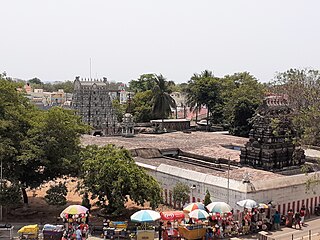
Sthalasayana Perumal Temple is at Mahabalipuram. Constructed in the Dravidian style of architecture, the temple is glorified in the Naalayira Divya Prabandham, the early medieval Tamil canon of the Alvar saints from the 6th–9th centuries CE. It is one of the 108 Divya Desam dedicated to Vishnu, who is worshipped as Sthalasayana Perumal and his consort Lakshmi as Nilamangai Thayar. The temple is believed to have been built by the Pallavas, with later contributions from the Medieval Cholas, Vijayanagara kings, and Madurai Nayaks.

The Pundarikakshan Perumal Temple or Thiruvellarai Temple in Thiruvellarai, a village in the outskirts of Tiruchirappalli in the South Indian state of Tamil Nadu, is dedicated to the Hindu god Vishnu. Constructed in the Dravidian style of architecture, the temple is glorified in the Naalayira Divya Prabandham, the early medieval Tamil canon of the Alvar saints from the 6th–9th centuries CE. It is one of the 108 Divya Desams dedicated to Vishnu, who is worshipped as Pundarikakshan and his consort Lakshmi as Pankajavalli.
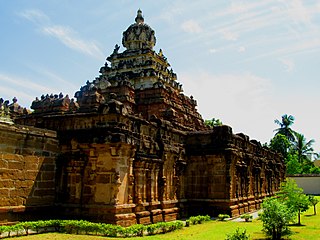
Thiru Parameswara Vinnagaram or Vaikunta Perumal Temple is a temple dedicated to Vishnu, located in Kanchipuram in the South Indian state of Tamil Nadu. Constructed in the Dravidian style of architecture, the temple is glorified in the Nalayira Divya Prabandham, the early medieval Tamil canon of the Alvar saints from the 6th through the 9th centuries CE. It is one among the 108 Divya Desams dedicated to Vishnu, who is worshipped as Vaikuntanathan and his consort Lakshmi as Sri Vaikundavalli. The temple is considered as the oldest extant temple in Kanchipuram.
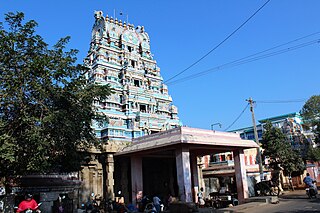
Tiruttalinathar temple is a Siva temple located in Thiruputhur near Karaikkudi. This temple is regarded as the 6th of the Tevara Stalams in the Pandya kingdom of Tamil Nadu. The temples Rameswaram and Tiruvadanai are the other Shivastalams nearby. It is one of the shrines of the 275 Paadal Petra Sthalams.
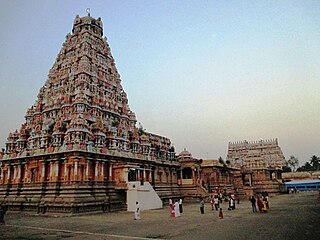
The Kampaheswarar Temple or kampa-hara-ishvarar is a Hindu temple dedicated to the god Shiva. It is situated in Thirubuvanam, a village in Thanjavur district in the South Indian State of Tamil Nadu, on the Mayiladuthurai-Kumbakonam road. Shiva is worshiped as "Kampahareswarar" as he removed the quaking of a king who was being haunted by a Brahmarakshasa. It was built by Kulothunga Chola III and is considered the last of the four masterpieces built during the Medieval Chola era.
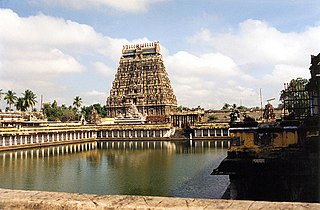
Iconography of Shiva temples in Tamil Nadu is governed by the Shaiva Agamas (IAST:Āgama) that revere the ultimate reality as the Hindu deity, Shiva. Āgama in the Hindu religious context means a traditional doctrine or system which commands faith. Temple worship according to Āgamic rules can be said to have started during the Pallava dynasty in South India, but they were fully under establishment during the Chola dynasty The temples during the Chola period expanded to Sri Lanka and islands in South East Asia. The temple complex was expanding with niches for various deities on the stipulated sides of the sanctum. Lingam was universalised and prakarams (precincts) with subsequent deities came up. The temple parivara expanded considerably during the Chola period. The niches of following Āgamic rules for building Shiva temples in Tamil Nadu, a South Indian state continues even in the modern era. Some of the prime images like that of lingam, Vinayagar and Parvati are present in all the Shiva temples. Almost all the temples follow the same custom during festivals and worship methods with minor exceptions. Most of the Shiva temples in Tamil Nadu and Sri Lanka are built in Dravidian architecture.
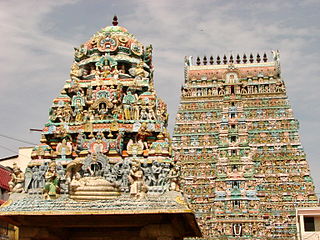
Tamil Nadu is known for its ancient temple architecture. Nearly 33,000 ancient temples, many at least 800 to 2000 years old, are found scattered all over Tamil Nadu. As per Tamil Nadu Hindu Endowments Board, there are 38,615 temples. Most of the largest Hindu Temples reside here. Studded with complex architecture, a variety of sculptures, and rich inscriptions, the temples remain the very essence of the culture and heritage of Tamil land, with historical records dating back to at least 3,000 years.
Seeyamangalam is a small village in Vandavasi taluk in Tiruvannamalai district in the Indian state of Tamil Nadu. The major occupation of the people living at this place is agriculture. As of 2011, it had a population of 1665. The place is known for the Avanibhajana Pallaveshwaram temple.

The Sundaravarada Perumal Temple in Uthiramerur, a village in the South Indian state of Tamil Nadu, is dedicated to the Hindu god Vishnu. Constructed in the Dravidian style of architecture, the temple. The temple is glorified by various acharyas and is one of the 108 Abhimana Kshethram dedicated to Maha Vishnu. Vishnu is worshipped as Sundaravarada Perumal and his consort Lakshmi as Anandavalli. The temple was originally built by Pallavas, with later additions from the Cholas, Pandyas, Sambuvarayas, Vijayanagara Rayas and the Nayaks.
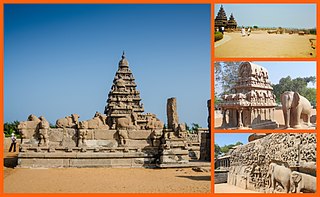
The Group of Monuments at Mahabalipuram is a collection of 7th- and 8th-century CE religious monuments in the coastal resort town of Mahabalipuram, Tamil Nadu, India and is a UNESCO World Heritage Site. It is on the Coromandel Coast of the Bay of Bengal, about 60 kilometres (37 mi) south of Chennai.

The Shore Temple is a complex of temples and shrines that overlooks the shore of the Bay of Bengal. It is located in Mahabalipuram, about 60 kilometres (37 mi) south of Chennai in Tamil Nadu, India.

Ganesha Ratha is a temple in Kancheepuram district, Tamil Nadu, India. It is one of ten rathas ("chariots") carved out of pink granite within the group of monuments of the Pallava Period at Mahabalipuram, a UNESCO-inscribed World Heritage Site since 1984. The ratha is an example of monolith Indian rock-cut architecture dating from the late seventh century during the reign of King Mahendravarman I and his son Narasimhavarman I. Initially constructed with a Shiva Linga, it is now deified with a Ganesha deity after the linga was removed.

Mamandur is a village in Tiruvanamalai district of Tamil Nadu, India. It is located on the Kanchipuram - Vandavasi road, near Dusi and about 15 km from Kanchipuram. It is known for the 7th-century rock-cut cave temple, housing a Tamil Brahmi inscription, one of the monuments of national importance as declared by the Archaeological Survey of India.

Othandeeswarar Temple in Thirumazhisai Chennai City in Tiruvallur district in the South Indian state of Tamil Nadu, is dedicated to the Hindu god Shiva. It is located 22 km from the state capital Chennai. Constructed in the Dravidian style of architecture, the temple was built during the 11th century by Chola king Kulothunga Chola II. Shiva is worshipped as Othandeeswarar and his consort Parvathi as Kulirvithanayaki.
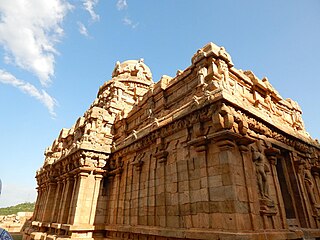
Vijayalaya Choleeswaram in Narthamalai, a panchayat town in Pudukottai district in the South Indian state of Tamil Nadu, India, is a temple dedicated to the Hindu god Shiva, Vishnu and houses the 8th century Jaina Abode. The temple is considered one of the oldest stone temples in South India. The other portions of Narthamalai houses the 8th century Jaina Abode, the Aluruttimalai Jain Caves. The Temple is Constructed in the Dravida style and rock cut architecture, the temple is believed to have been built during the 9th century by Mutharaiyar dynasty kings, the cardinals of Pallavas, with later expansion from the Cholas. The rock-cut architecture is an early example of Cholan Art, continuing the tradition of the Pallavas.

Kunnandarkoil Cave Temple in Kunnandarkoil, a village in Pudukottai district in the South Indian state of Tamil Nadu, is dedicated to the Hindu god Shiva. Constructed in Rock-cut architecture, the temple is believed to have been built during the 8th century by Muttaraiyar kings, the cardinals of Pallavas, with later expansion from the Vijayanagar Empire. The rock-cut architecture in the temple is a specimen of the late Pallava Art and an early example of Chola Art. The temple has various inscriptions from Cholas, Chalukyas, Pandyas and Vijayanagar Empire. The temple is considered one of the oldest stone temples in South India. The temple is maintained and administered by Department of Archaeological Survey of India as a protected monument.

Kunnakudi Shanmughanathar temple in Kundrakudi, a village in the outskirts of Karaikudi in Sivaganga district in the South Indian state of Tamil Nadu, is dedicated to the Hindu god Murugan. Constructed in the Hindu style of architecture, the temple is located in the Tirupattur - Karaikudi Road, around 14 km (14,000 m) from Karaikudi. There are three caves located on the western side of the lower rock, that has rock-cut shrines from the Pandyan Empire from the 8th century. The caves have the earliest sculptural representation of Dvarapalas, the guardian deities, for any South Indian temple.























